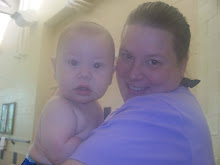So that said---the best seat---fits your car, fits your child, fits your budget and will be used correctly each and every time. You can go out and buy the most expensive seat, but if you don't install it correctly and use the harness correctly---IT WON'T WORK in a crash! On the flip side, you can get the cheapest seat out there, use it correctly and have it work properly in a crash.
Well then, why should you keep reading? All you need to do is use the seat right, it doesn't matter which one you chose...right? Well it's knowing how to find the best seat for YOU. What works in my car, might not work in yours. What I find easy to use, you might find a bit more complicated. Although I will tell you, I tend to get the stuff that's easy to use. I'm not the only one that has to use it. My husband needs to be able to buckle our child correctly too. I want something that's easy to explain to someone else...whether it's to my hubby, the grandparents or a sitter. Be aware that most employees in the big box stores will have little to no training on what you should be looking for in a carseat or how to use one, so don't expect them to be able to give you reliable information.
Infant seats are the seats that can ONLY face the rear of the car. They are supposed to face that direction. This allows the seat to be reclined for baby, keeping it's airway open. It also protects that fragile head, neck and spinal column. They have a handle that can be rotated up to carry the seat and rotated out of the way to get baby in and out. They have a base that stays in the car and the seat clicks in and out. Most seats you can use without the base in a pinch. The benefit to a base is that it stays installed once it's in the car correctly. If you are installing just the seat time after time, you're more likely to make a mistake at some point.
So what should you look for, in no particular order:
- Easy to adjust harness tightness-Seats adjust the strap tension from the front or the rear. If it's from the front, there will be a single strap near where the baby's feet will be. If it's from the rear, there will be one or two straps hanging off the back behind where the baby's shoulders would be. Now try adjusting the straps. From the front it'll be easy. Now that seat with the rear adjust--try adjusting it. Imagine baby is in the seat---so you can't turn it over, and be careful how far forward you tip the seat, don't want to cut off baby's airway! And remember you could need to adjust the tightness each and every time you take baby in and out of the seat. My personal preference is to use a seat with an adjuster that's near the baby's feet. When they're tiny, you can easily loosen the straps to get baby in and then snug them back up.
- Easy to change strap height-Your baby is going to grow. Eventually you'll need to move those straps up. It's not something you'll need to do frequently, but you want it to be easy. On some seats you'll see a metal plate on the back. The 2 shoulder straps will attach at the top and there will be one strap coming off the bottom. Now these are the seats that are the easiest to change the strap height in my opinion. All you do is unhook the shoulder strap, feed the strap out of the current shoulder slot, feed it back into the next strap height and re-attach to the metal piece. Now the other way to adjust the strap height is a bit more complicated. You have to remove the entire strap from where it attaches near the baby's hip. On some seats, you have to take the the chest clip AND buckle off the strap and then pull the strap out of the current position, put it into the correct position, put the chest clip and buckle back on the strap (correctly too) and then back through the hole at the hip. So...turn that seat around and look for that piece of metal!
- Where does the handle go in the car-I know driving down the road, you look in the car and see the carseats. Some have handles up, some have the handle down. So I guess it's ok to leave them all up? Actually it depends on which brand you purchase. The only way you'll know is to look in the manual. Some brands allow you to leave it up or down, some say it has to be up, some say it has to be down, and others still say you have to leave one and a half inches between the carseat and the vehicle seat in front of it. The manuals should be on the seat when you look at them in the store.
- Used Seats- Some parents wonder about saving some money and using a used seat. This might be ok, but it might not be. I'm all for saving money, but not at the expense of my child's life. First, make sure the seat is from someone who you would trust with your child's life. They didn't mistreat the seat, didn't wash the straps with harsh chemicals or in the washing machine. Then, find the expiration date on the seat. This could be molded into the plastic or on a sticker. Sometimes it's not listed and you have to add X number of years to when the seat was made. If you can't find the date for when the seat was made--it's not safe for you to use. If you can find the date it was made, but not when it expires, call the company that made the seat or look at the FAQs on their company website. Ok...so lets say that seat your sister's little boy used is not expired, now you've got to check to see if it's been recalled. Some recalls are for something that affects the way the seat performs and others are because a phone number that was required to be on the seat by law wasn't. The easiest way to find out if the seat is recalled, for what, if it was fixed or should be destroyed is to call the manufacturer. Their number will be on a sticker on the seat. Call them. Now---you need to ask the original owner if they have the instructions, if they do great...if not, call the manufacturer. Most will send you a copy free or tell you how to download and print a copy off of their website. Do this...you MUST read the instructions to learn how to install and properly use the seat. So yes---a used seat can be a safe seat, you just need to make sure it's been correctly cared for, never been in a crash, not expired and not recalled or fixed if it was.
- Weight Limits--all seats out there come with a weight range to use the seat for. 5-22 pounds is probably the most common range you'll find. Some seats start at 4 pounds and I think there is at least 1 seat that starts at birth. There are also seats that go all the way up to 35 pounds. The higher weight limits will generally allow you to use the seat longer. We didn't use an infant seat very long because I was itching to get a convertible seat. I think if I had to do it again, I might get a seat that would get us through 2 winters. Taking a coat on and off a toddler to get him in and out of the car is tiresome. You have to decide what will work best for your family. Think beyond when they're itty bitty to what if you have older children in activities and baby is a late walker.
- Test Fit-Some big box stores will allow you to take the seat out to your car and do a test fit. Sure some stores have a bench seat to try the seat on, but it's probably not shaped like the one in your car AND there's no front seat. Take the seat out to your car and see if it fits. Don't forget to make sure there is enough room to get the seat in and out and room for the handle to be down if necessary.
- Read Your Car Manual- Now this something you should probably do before you get to the store to do a test fit. Know how to lock your seat belts, understand where the approved LATCH positions are in your car. Most cars don't allow you to use the lower anchors in the center of the back seat.
So now that you've got your seat. You're looking around the store and you see a bunch of stuff---mat for under the seat, head support, body support, mirror, toy bars, dangle toys, etc. So do you need all that. The short answer is NO. Only use what came in the box with your seat or approved accessories available from the manufacturer of the seat. The one thing that I added to my infant car seat was a shower cap style cover. It only went over the top of the seat, so it didn't go under the baby or affect the harness in any way. I could easily put my son in, add a hat and a blanket for extra warmth, zip the cover and go! It kept blankets from blowing off in the wind and I could unzip and take blankets off of him if the car got too warm.
I know it's a lot of info to take in. Read it a couple times. Ask questions. Happy Shopping!
Susan



